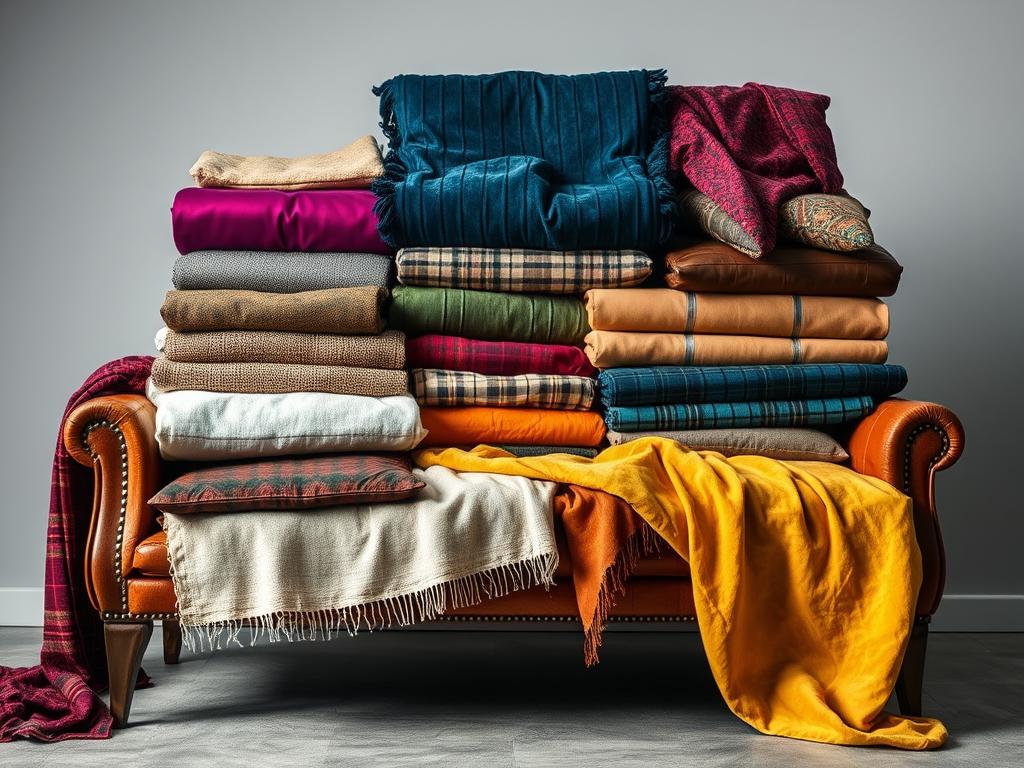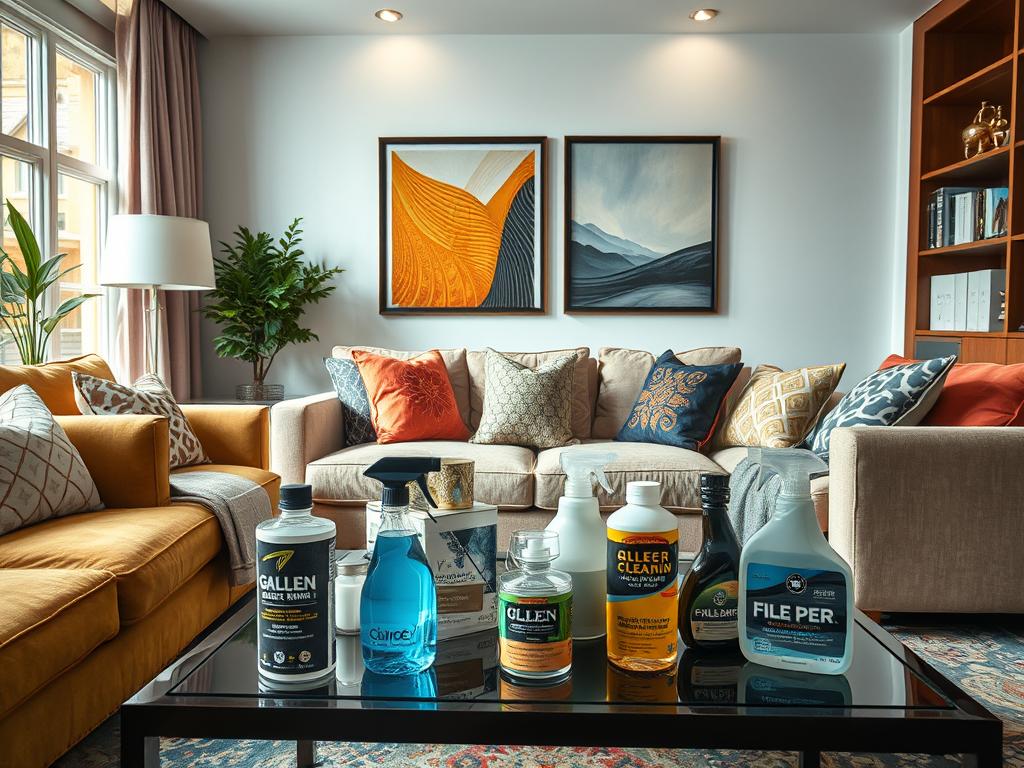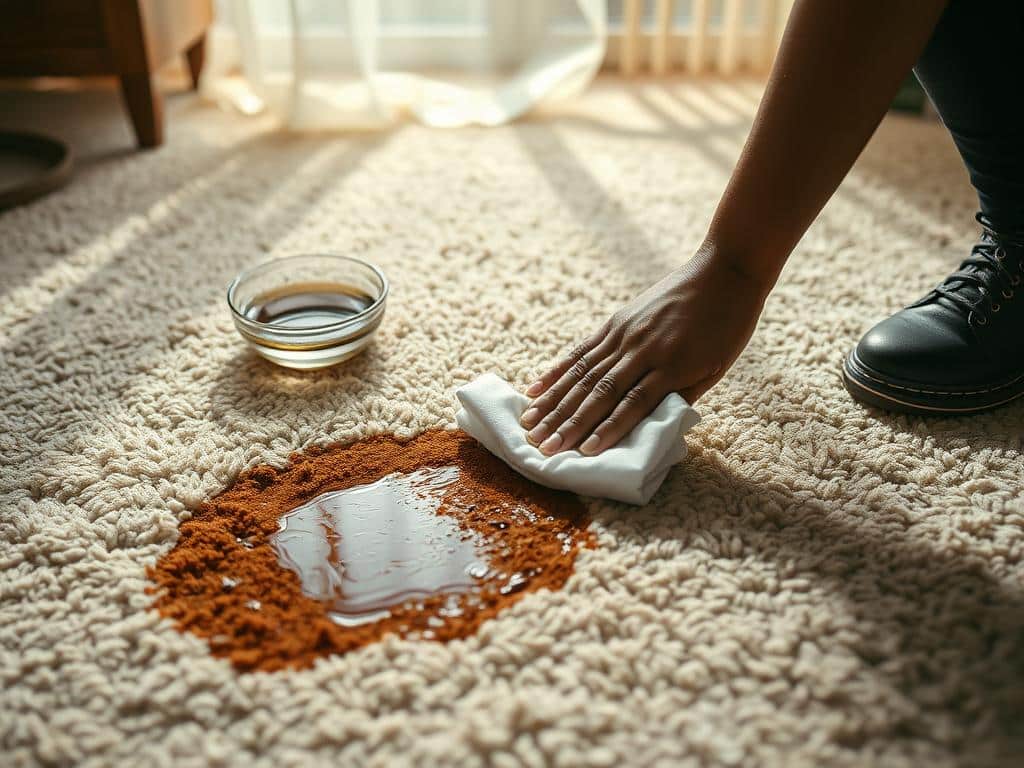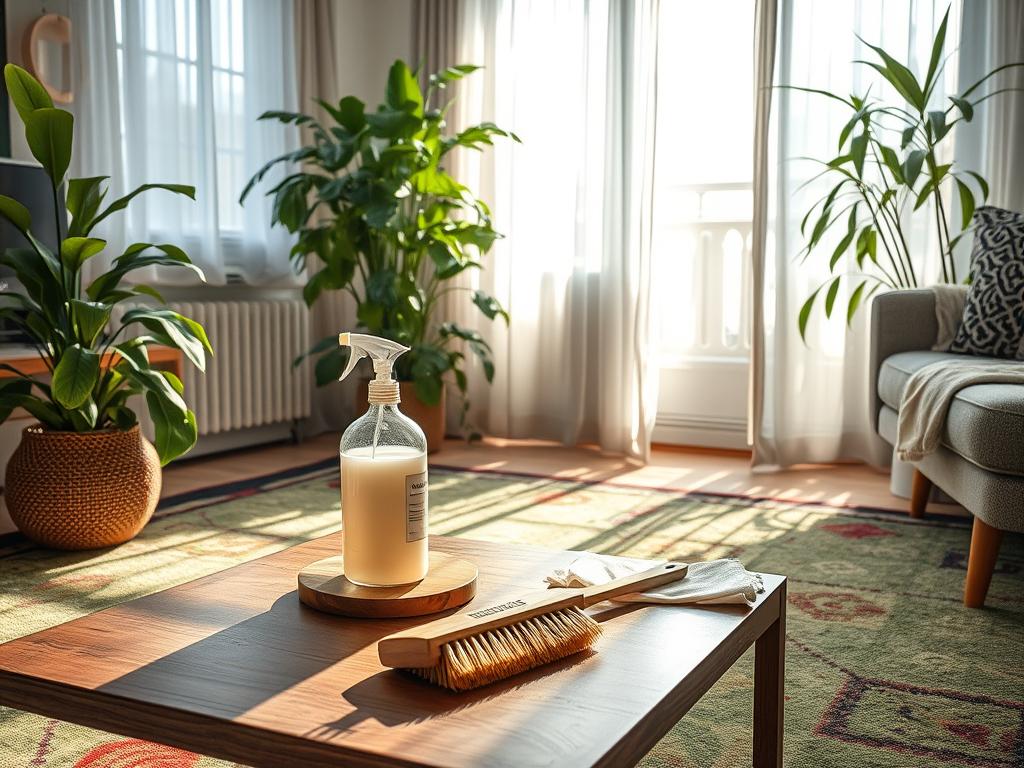
Thinking of giving your living space a new look? Know the different furniture fabric options. Each type, from natural to synthetic, has its own perks for comfort and design. This guide helps you pick the right fabric by explaining types, traits, and advantages.
Cotton is great for those on a budget, offering both comfort and strength. Leather shines for lasting long and being easy to clean, perfect for homes with pets. For synthetics, Polyester and Olefin (Polypropylene) stand out for their toughness and resistance to stains. Choosing ethically sourced fabrics is key; they last longer and support sustainability.
Assessing upholstery fabrics for quality, durability, and ethical production boosts your furniture’s comfort and look. It also promotes a greener living. Next, we explore natural and synthetic fabrics more, to find the best match for your needs.
Introduction to Upholstery Fabrics
Choosing the right fabrics for your furniture is vital in home decorating. The right choice boosts the look and life of your pieces. This guide talks about different types of upholstery materials and their specific traits.
Cotton is affordable and varies from rough textures to soft chintz. It’s important to note, though, it can wear down over time.
Silk adds luxury but isn’t great for frequent use as it wears quickly. Wool, however, is strong against pilling and stains, making it good for busy areas.
Leather is tough, making it ideal for busy homes with pets. It can be mixed with vinyl to save money. It’s known for lasting much longer than fabric options.
Synthetic fabrics like polyester are also popular for their durability and flexibility. Olefin is another good choice, ranking high in synthetic fiber production. Both are noted for their toughness.
Nylon excels in preventing the flattening of plush fabrics. Acrylic is valued for its colorfastness, suitable for outdoor pieces.
Rayon is strong but prone to wrinkling. It’s used in various items. Be careful with acetate and Olefin in sunny spots as they might fade.
A recent article stresses the importance of these features in selection. Synthetics can mimic natural fibers like wool and silk. This gives you many options to meet your desires and needs.
Natural Upholstery Fabrics
Natural fabrics are beloved in interior design for their beauty, comfort, and usefulness. Favorites include cotton, silk, wool, leather, and linen. Each fabric brings special features for different household needs and tastes.
Cotton
Cotton is chosen for its good price and flexibility. It absorbs colors and designs easily, fitting many decor styles. While cotton stays bright, it can stain and may need extra care.
Silk
Silk stands for luxury and grandeur. Its rich texture fits formal spaces best. Yet, silk needs professional cleaning, which can add to its upkeep costs.
Wool
Wool is unbeatable for busy places because of its strength. It naturally resists stains, keeping your furniture looking clean. Still, wool can smell when it’s wet, so this needs attention.
Leather
Leather is celebrated for lasting a long time, perfect for homes with pets or kids. It’s simple to care for and ages gracefully, gaining a unique look over time.
Linen
Linen stands out with its complex weave and natural elegance. Though beautiful, it requires professional cleaning. It’s also cool to sit on in hot weather.
Looking at the charm of natural textiles or the sturdiness of leather and wool, each material has its perks. They can make your home both stylish and practical.
Synthetic Upholstery Fabrics
Synthetic fabrics for upholstery are truly popular. They’re super durable, easy to look after, and don’t cost too much. They’re made to last through a lot of use. This makes them great for homes and public places alike.
Polyester
Polyester is a go-to synthetic fiber because it’s so tough and flexible. You can find it in many colors and designs. It’s really good at keeping stains away. It mixes well with other fabrics, like cotton or wool, to keep from wrinkling. This makes it just right for families that are always on the go.
Olefin (Polypropylene)
Olefin fabric, or polypropylene, is amazing at keeping stains off and staying strong. It’s a favorite for outdoor and sturdy upholstery without needing special treatments. It’s very straightforward and ideal for everyday use.
Nylon
Nylon upholstery is known for lasting a long time. It’s usually mixed with other fibers to help the fabric stand up to wear and tear. This blend is perfect for areas that get a lot of foot traffic, like in houses or public places.
Acrylic
Acrylic fabrics are chosen for outdoor furniture because they can handle sunshine, mold, and mildew. It keeps its shape and color well, even after lots of time outside. This makes it a standout for outdoor areas or places that get a lot of sun.
Rayon
Rayon fabric looks luxurious, much like linen, but is more budget-friendly. It’s made from wood pulp and often mixed with other materials to make it stronger. However, it needs careful handling and can stretch, something to keep in mind for high-use spots.
Synthetics like polyester, olefin, nylon, acrylic, and rayon bring many pluses. They are easy to use, strong, and look good. They’re a leading choice for anyone wanting to update their furniture.
Understanding Fabric Durability: The Martindale Rub Test
The Martindale Rub Test is a top way to check fabric strength, especially in Europe and the UK. It measures how many rubs a fabric can handle before it shows wear. This helps people pick the right fabric strength for home or business needs.
Domestic Use
Fabric strength is very important for home furniture. Fabrics used at home usually have a durability of 10,000 to 25,000 rubs. For items not often used, a rub count of 9,000 to 12,000 is okay.
But, things like sofas used every day need a rub range of 15,000 to 25,000. For busy homes with kids and pets, look for fabrics with 25,000 to 30,000 rubs. They last longer and look good, too.
Commercial Grade
Commercial spaces need very strong fabrics because of more use. These places often choose fabrics that have more than 35,000 rubs. For areas like hotels and cafes, the rub count can be between 50,000 to 100,000 or even higher.
This high rub count means the fabric can handle lots of use. They’re great for busy places.
Learning about the Martindale Rub Test helps you pick the best upholstery. Whether it’s for your home or a business, choosing the right rub count means your fabrics will last longer and you’ll be happier with them.
Fire Resistance in Upholstery Fabrics
Making sure upholstery fabrics are fire-resistant is key to making furniture safer. There are tests like the match test and cigarette test to check if textiles resist fire. For places at higher risk, we use the Crib 5 and Crib 7 tests. Crib 5 is for spots like restaurants and hotels. Crib 7 is chosen for hospitals and prisons.
When picking fire-safe upholstery, it’s vital to know the difference between non-durable and permanent flame-retardant fabrics. The latter, which are perfect for places like hospitals and hotels, don’t lose their fire resistance after being washed. This is crucial for keeping places like schools, churches, and theaters safe. Especially since some areas have laws requiring fire-safe textiles.
In the U.S., upholstery fabrics must meet specific standards by groups like the Upholstered Furniture Action Council (UFAC). These standards test how fabrics burn, create char, and produce smoke. In some public areas, using special barriers under regular fabrics is needed to meet fire safety rules.
There are mainly two kinds of flame-retardant upholstery materials. There are Inherently Flame Retardant (IFR) fabrics and ones treated with chemicals. IFR fabrics keep their safety features after washing, giving them an edge for long-term protection. These materials have to follow the NFPA 701 standards in the U.S. It covers textiles in curtains, blankets, and other home items.
In places that face a high risk of fire, having flame-retardant upholstery is critical. Getting a notarized Certificate of Compliance proves the fabric meets safety standards. Such a certificate ensures compliance with NFPA 701, UFAC Class 1, and Cal. Tech. Bull#117, Sec. E. It’s a big step towards fire safety.
Upholstery Fabric Types
Discovering the wide range of upholstery fabric types can greatly change your choices in furniture and design. There are many kinds of fabrics like woven, non-woven, and embroidered. Each type comes with its own special features. Learning about them helps you make better choices for your furniture.
Woven fabrics such as cotton and wool mix comfort with strength. Cotton is affordable, making it great for those watching their spending. Wool is tough and resists wear, making it ideal for busy spots. Leather stands out for its durability. It’s very pet-friendly because it’s easy to keep clean.
Non-woven fabrics, like olefin and polyester, are strong and versatile. Olefin is very common and simple to clean without extra treatments. Polyester is chosen for many uses and is often mixed with other materials to make it stronger and last longer.
Embroidered and different weaving methods add unique style touches. You can choose between hand-made or high-end printed designs. These options offer custom and creative looks. Digital printing also allows for complex designs on any type of fabric.
Finding the right balance in fabric stretch and stability is key for lasting beauty and use. When picking a fabric, think about upkeep, comfort, and how much you want to spend. Durable materials like leather are best for busy places. More delicate fabrics, such as silk, are better for areas that get less use. Also, consider fabrics with weaves that mix long life with great design.
Choosing sustainable upholstery fabric types is important too. Go for recycled or organic materials and those with eco-friendly dyes. Picking long-lasting materials helps cut down on waste and is better for the planet.
Knowing about different fabric types and what they offer can improve your furniture choices. By doing so, your upholstery will not only look good but also last longer and be easier to care for.
Sustainable and Eco-Friendly Fabric Options
More people now want to use sustainable textiles in their everyday lives. This includes fabrics for furniture. There are eco-friendly options that are both stylish and good for the planet. Some of these include recycled materials, organic fabrics, and eco-friendly dyes. Let’s take a closer look at these choices.
Recycled Fabrics
Recycled fabrics help cut down waste and save resources. For example, recycled polyester is made from old polyester materials. It reduces trash and uses less energy. Two Sisters Ecotextiles offers a variety like Sequoia, Columbia, and Methow with different colors and textures. Recycled leather gives old leather a new life, decreasing energy use. Recycled plastic, also known as RPET, turns plastic waste into new fabric. This helps fight pollution.
Organic Fabrics
Organic fabrics are great for those who want to lessen their environmental impact. Organic cotton is grown without harmful chemicals, making it a safer choice. Linen needs less water and is biodegradable. Wool and hemp are also organic options. Hemp grows faster and produces more fiber than cotton. Two Sisters Ecotextiles has organic fabric options like Dungeness and Kapowsin. These fabrics are both high-quality and eco-friendly. They come in colors like Indigo and Soft Green.
Low-Impact Dyes
The beauty of textiles doesn’t have to harm the environment. Low-impact dyes are the solution. They meet strict environmental standards. They use less water and fewer chemicals. Thanks to these dyes, brands like Two Sisters Ecotextiles can offer attractive fabrics like Buffalo Check and Mottled Linen. This way, they don’t harm the planet.
Choosing sustainable textiles like recycled materials, organic fabrics, and eco-friendly dyes is a smart move. It helps the environment while giving you quality, durable fabrics. As more people want eco-friendly options, the variety and accessibility of these fabrics continue to increase.
Factors to Consider When Choosing Upholstery Fabric
When picking out upholstery fabrics, knowing how they handle wear is key. Durability is crucial, especially in places that get a lot of use. Fabric choice affects both the look and life of furniture.

Some materials, like leather and synthetics, are great for everyday use and pets. Leather gets nicer with age but needs care from too much sun. Think about how the fabric will look over time and its care needs.
How a fabric looks is also important for your home. The color and texture of the fabric can change a room’s feel. Neutrals work well with many styles, and textures add depth.
Even on a budget, you can find quality fabrics. Brands like Swedish brand Hem have samples to try before buying. Look for durability and value in your fabric choices.
Visiting showrooms helps you learn about fabric care and quality. Asking about thread counts can help you find durable and comfortable options. Pick what works best for your home’s needs.
Conclusion
Exploring the world of upholstery fabrics shows it’s key to pick materials that match your lifestyle, environment, and furniture needs. Fabrics like luxurious velvet, durable leather, and moisture-resistant olefin offer ways to meet both aesthetic and functional goals. These choices help achieve the look and feel you desire for your space.
It’s crucial to focus on durability, comfort, and sustainability when choosing fabrics. Knowing the difference between natural fabrics like soft cotton and wool, and synthetic ones like resilient polyester and nylon helps. This knowledge ensures your furniture not only looks great but lasts long.
Thinking about where fabrics come from and their impact on the environment is vital. Choosing eco-friendly options like recycled materials and organic fibers shows a dedication to sustainability. It boosts the worth of what you buy. In sum, the right blend of quality, style, and ethical choices makes your home both beautiful and responsible.



